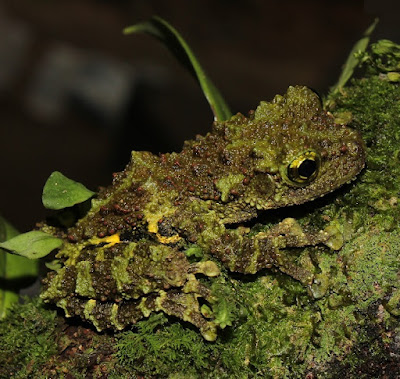 |
| Theloderma khoii Ninh, Nguyen, Nguyen, Hoang, Siliyavong, Nguyen, Le, Le & Ziegler, 2022 Khoi’s Mossy Frog | Ếch cây sần khôi || |
ABSTRACT
We describe a new species of Theloderma from northeastern Vietnam based on morphological differences and molecular divergence. Theloderma khoii sp. nov. is distinguishable from its congeners on the basis of a combination of the following characters: large size, SVL 52.1 mm in male, 59.4 mm in female; head length and width equal; vomerine teeth present; snout pointed and truncated, eye large, ED 4.7 mm in male, 5.6 mm in female, spinules on upper eyelid; tibiotarsal articulation reaches to the posterior border of the eye or the tip of the snout; dorsal skin very rough with large irregular gland ridges and warts, ventral surface of body granular; tips of all digits dilated but all considerably smaller than tympanum; dorsal surface mossy green or olive mottled with dark magenta. The distribution of the new species is unknown but probably extends into adjacent high elevation forested areas in Ha Giang Province, Vietnam and in Yunnan Province, China with an extent of occurrence of only < 1000 km2 and continuing decline in the quality of its habitat due to deforestation. Thus, we suggest the species should be considered Endangered following IUCN’s Red List categories.
Keywords: Theloderma khoii sp. nov., karst forest, molecular phylogeny, taxonomy, Ha Giang Province
Class Amphibia Gray, 1825
Order Anura Fischer von Waldheim, 1813
Family Rhacophoridae Hoffman, 1932
Genus Theloderma Tschudi, 1838
Theloderma khoii sp. nov.
Diagnosis: Theloderma khoii sp. nov.shows the diagnostic characters of the genus Theloderma, for instance a distinct tympanum, round canthus rostralis, bony ridges from canthus rostralis to occiput absent, and skin of head not co-ossified to the skull, and also molecular analyses revealed it to be nested within Theloderma. The new species is distinguished from its congeners and other small rhacophorid species by a combination of the following characters: 1) large-sized frog of the genus Theloderma (SVL 52.2 mm in a single male, 59.4 mm in a single female); 2) head length and width equal; 3) vomerine teeth present; 4) snout pointed and truncated (SNL/SVL 16.3% in male; 16.0% in female); 5) eye large, eye diameter about a half of snout length (ED/SNL 54.60% in male; 58.9% in female), spinules on upper eyelid; 6) tibiotarsal articulation reaching to the posterior border of the eye or the tip of the snout; 7) dorsal skin very rough, with large irregular gland ridges and warts, ventral surface granular; 8) fingers rudimentary webbed, toes almost four-fifths webbed, tips of all digits dilated but all considerably smaller than tympanum; 9) dorsal surface mossy green or olive mottled with dark magenta; 10) lateral and ventral surfaces black with irregular lemon yellow pattern and some white granules; 11) male with large nuptial pads and an inner vocal sac.
Etymology: The specific epithet is in honor of Professor Dr Le Vu Khoi of the VNU Hanoi University of Science, Ha Noi, Vietnam, in recognition of his great support of teaching, mentoring, research and conservation work in Vietnam.
As common names we suggest Khoi’s Mossy Frog (English) and Ếch cây sần khôi (Vietnamese).
Hoa Thi Ninh, Tao Thien Nguyen, Huy Quoc Nguyen, Ngoc Van Hoang, Sonephet Siliyavong, Thinh Van Nguyen, Dzung Trung Le, Quyet Khac Le and Thomas Ziegler. 2022. A New Species of Mossy Frog (Anura: Rhacophoridae) from Northeastern Vietnam. European Journal of Taxonomy. 794(1), 72–90. DOI: 10.5852/ejt.2022.794.1655
